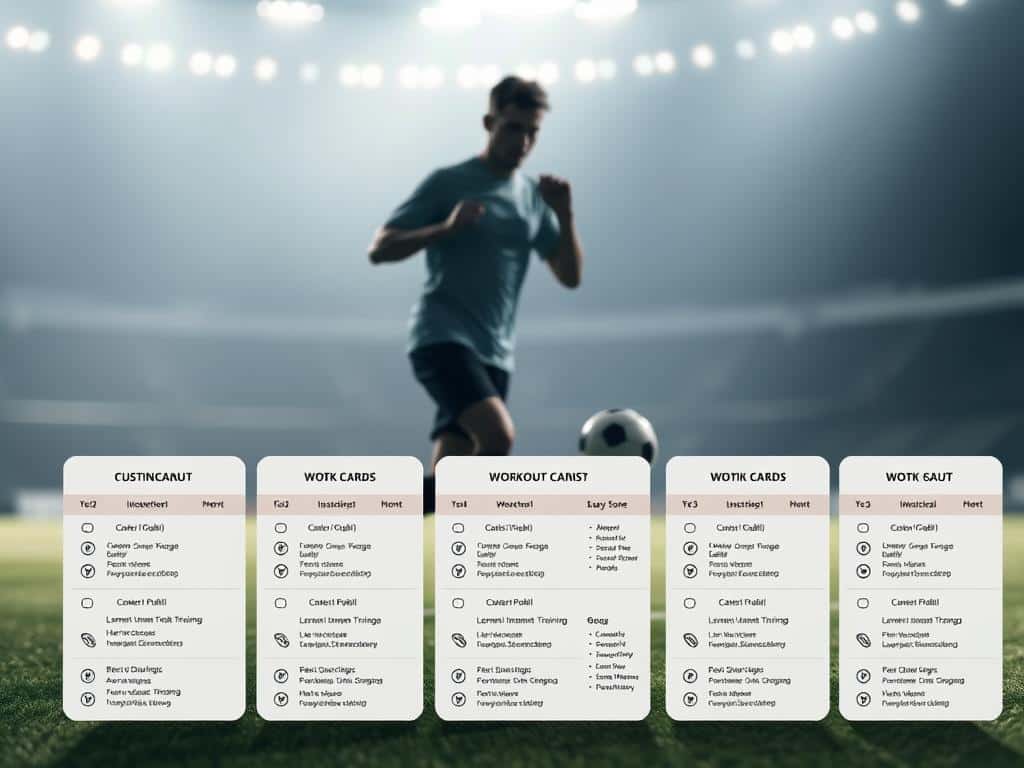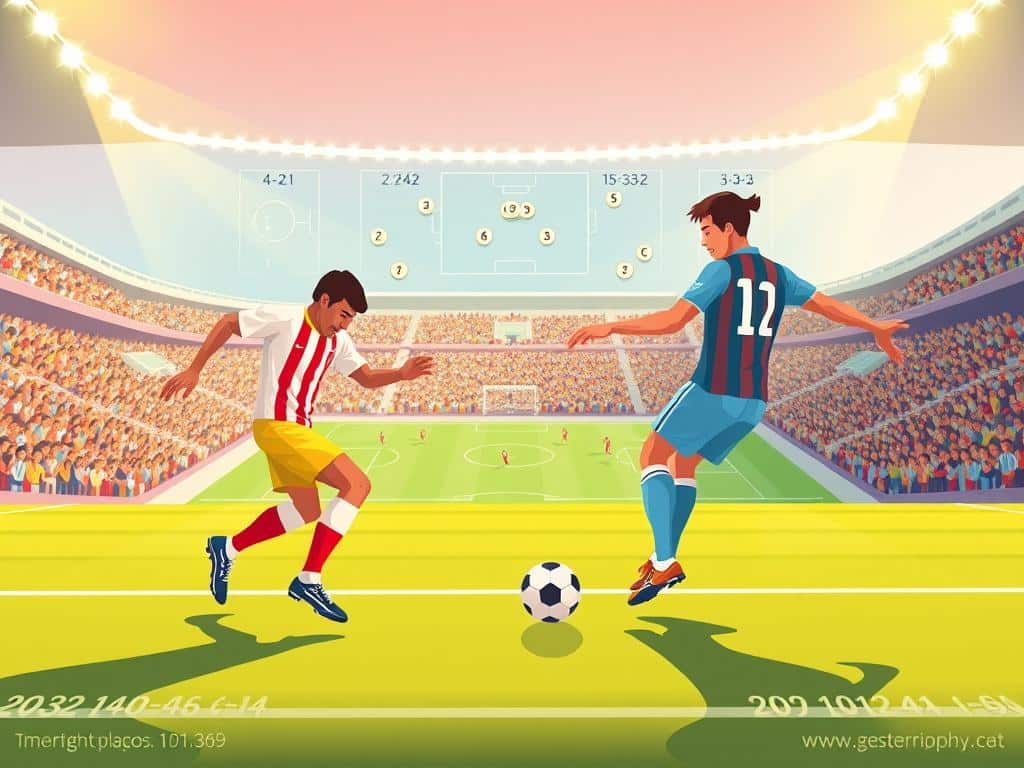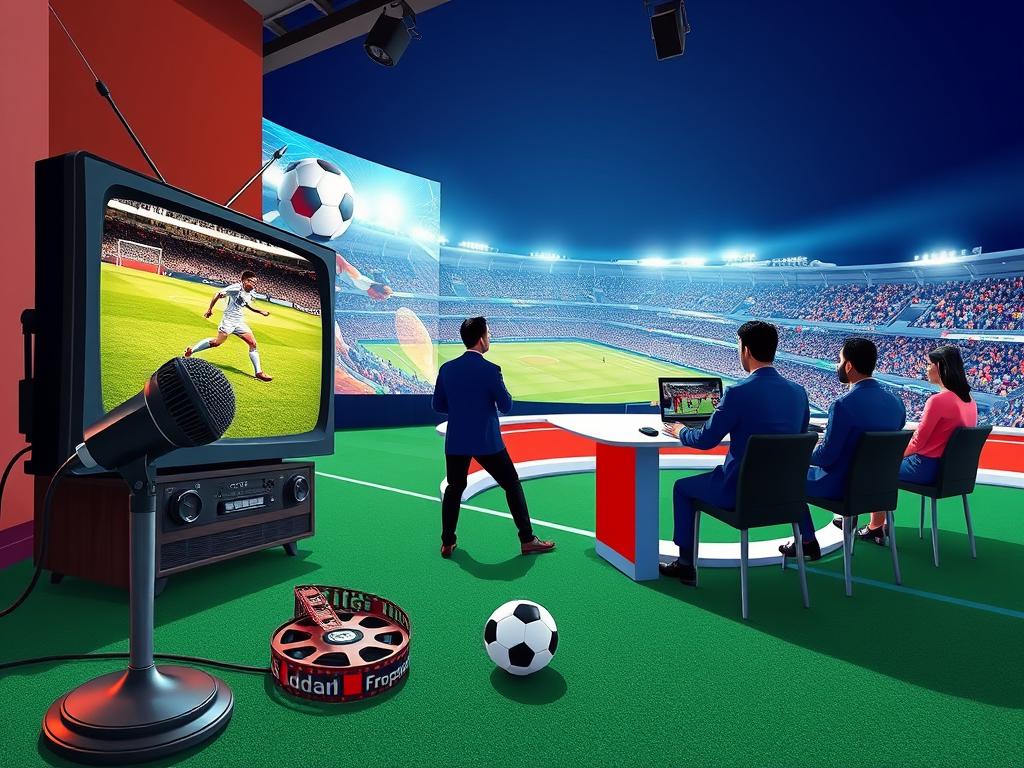Surprising stat: across 90 studies, about seven weeks of structured jump training delivered clear gains in sprinting, cutting, and aerial play for soccer players!
Want more pop in your first step and takeoff? Smart training taps the stretch-shortening cycle so you store elastic energy and release it fast.
These methods use near-maximal jumps, short rests, and one to two sessions per week. The big win is transfer: practice mirrors match actions, so gains appear on the field.
No fancy gear required. You need intent, crisp movement, and planned sets and rests. When organized well, jump training boosts speed, power, and agility without bloating your schedule.
This intro previews science and simple, plug-and-play routines that hit vertical, horizontal, and lateral patterns. Ready to turn practice into on-field results? Let’s jump in!
Key Takeaways
- Seven-week, 1–2x weekly jump training often improves sprinting and jumping.
- The stretch-shortening cycle is central to fast, powerful actions.
- Short rests keep output high; sessions should be intentional and well timed.
- Low equipment needs make this training easy to add to team routines.
- Focused work transfers well to match demands—speed, strength, and agility.
Why Plyometrics Matter for Soccer Performance Right Now
Looking to turn quick bursts into game-changing plays? Jump training targets the exact actions players use every minute of a match.
Speed and agility depend on the stretch-shortening cycle. This cycle stores elastic energy during a fast bend and releases it on the way up. Train it right and your first step, sprint drive, and cut get noticeably sharper.
Speed, agility, and the stretch-shortening cycle explained
Rapid eccentric-to-concentric transitions let you produce force faster. That equals quicker sprints and snappier direction changes. Keep form tight: land softly, brace the hips, and prepare for the next rep.
On-pitch transference: sprinting, change of direction, and jumps
Research shows focused jump training improves sprint times, vertical jump, and change-of-direction tests. These gains transfer to match actions—short accelerations, sudden stops, and aerial duels.
- Short sets and controlled rest preserve quality.
- Minimal equipment needed—grass or turf works fine.
- Clean movement beats high volume for durable gains.
| Goal | Key Benefit | Practical Tip |
|---|---|---|
| Faster first step | Quicker acceleration | Use short, explosive jumps with 30–60s rest |
| Sharper cuts | Improved change of direction | Include lateral jump drills with emphasis on form |
| Higher aerial play | Better vertical power | Mix drop jumps and controlled landings |
The Science Snapshot: What research says about jump training in soccer
Research now gives a clear snapshot of how planned jump work moves the needle for players.
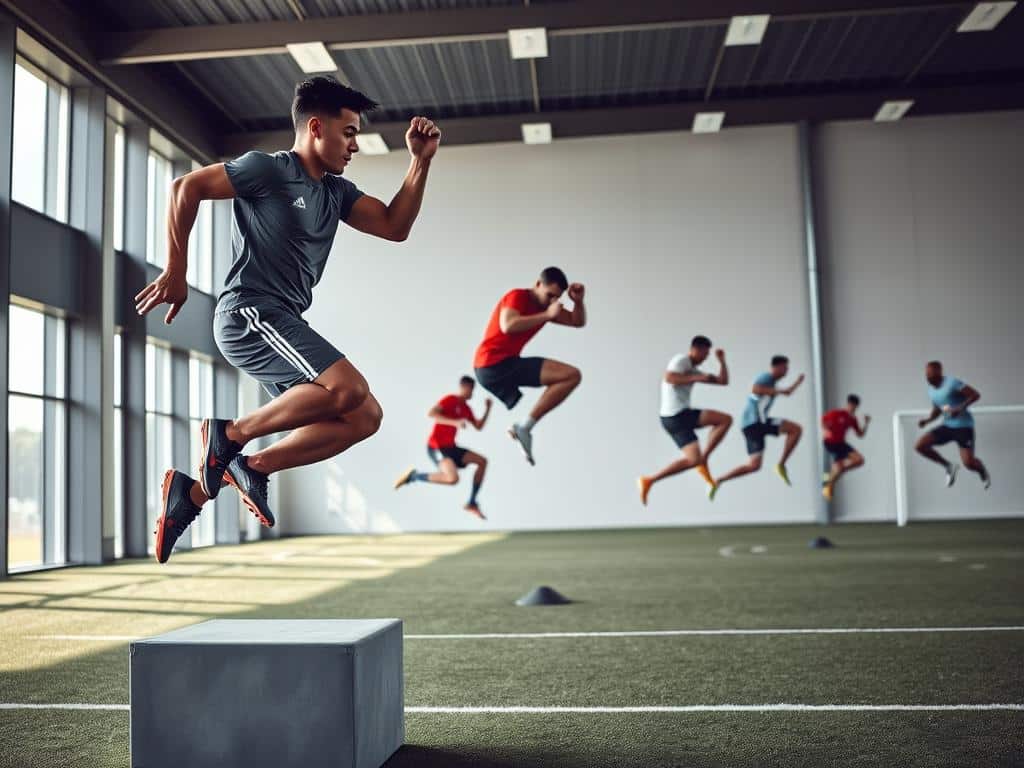
Systematic review and meta-analysis highlights for male and female players
A recent systematic review screened 7,556 studies and included 90 interventions. Only 12 involved female soccer players. Most studies focused on youth males and some lacked control groups.
Programming takeaways: duration, frequency, volume, and intensity
Practical rules from the review:
- Median effective length ≈ seven weeks; gains often begin by week four.
- Do 1–2 sessions per week; when weekly volume is matched, one vs two sessions shows similar gains.
- Target ~80 jumps per session at near-maximal intensity.
- Rest: inter-rep
- Train on grass and stay well rested to lower injury risk.
| Parameter | Recommended | Why it matters |
|---|---|---|
| Duration | 6–16 weeks (median 7) | Longer blocks yield bigger vertical gains |
| Frequency | 1–2 per week | Similar outcomes if weekly volume is equal |
| Volume & Intensity | ~80 jumps, near-max | Maintains power without excess fatigue |
Fast vs slow plyometrics: picking the right jumps for your goal
Not all jumps do the same job; pick the one that matches your performance target.
Fast, springy jumps have very short ground contact (≤0.25 s). Think pogos and low drop jumps. They train elastic recoil in the ankle and Achilles for sharper reactivity and quicker first steps.
Slow, muscular jumps spend more time on the floor (>0.251 s). Jump squats and broad jumps build raw power and horizontal drive. These lifts help players reach higher or farther in a single effort.
- Start drop jumps from ~30 cm and keep sets short: 3–4 reps chasing quick rebounds.
- Plate pogos can be submaximal (10–20 reps) to build rhythm and ankle stiffness.
- Broad jumps teach projection and controlled landings for usable acceleration.
- Prowler bounds with moderate load mirror on-field accelerations — full recovery matters.
| Goal | Best jump type | Rep guide |
|---|---|---|
| Speed/reactivity | Drop jumps, pogos | Short sets, crisp contacts |
| Horizontal power | Broad jumps, bounds | Moderate reps, controlled landings |
| Max power | Jump squats, loaded bounds | Fewer reps, higher load |
Keep form tight: athletic posture, stacked joints, and eyes forward. Choose elastic work for speed and muscular work for raw power — then match your training to the game.
Core soccer plyometric exercises by movement pattern
Break your training into movement lanes—vertical, horizontal, and lateral—to cover every match demand.
Vertical power
Squat jumps and jump squats build explosive height and raw strength. Pick low reps and full recovery so each rep is near-maximal.
Drop jumps train minimal ground contact. Use shallow drops and chase quick rebound to sharpen the stretch-shortening cycle.
Horizontal power
Broad jumps and bounds teach forward projection and balanced landings. Aim for distance with controlled deceleration.
Prowler bounds or short resisted sprints mimic the first three steps of an acceleration. Scale load to bodyweight for safe overload.
Lateral and multidirectional
Skater jumps and lateral bounds force frontal-plane control and boost change-of-direction ability. Line hops add quick contacts for foot speed and rhythm.
Program one vertical, one horizontal, and one lateral choice per session. Keep sets short, focus on crisp takeoff and soft landings, and progress to unilateral versions as control improves.
- Tip: Quality reps beat quantity—chase intent, not volume.
- Tip: Land hips back, knees tracking, chest tall to protect joints.
| Pattern | Key drills | Goal |
|---|---|---|
| Vertical | Squat jumps, drop jumps | Explosive height, jump power |
| Horizontal | Broad jumps, bounds, prowler bounds | Forward drive, acceleration mechanics |
| Lateral | Skater jumps, lateral bounds, line hops | Cutting control, foot speed |
soccer plyometric exercises: the definitive listicle
Use these focused moves to build quick rebounds, single-leg strength, and cutting control. Each option targets a specific need: reactive ankle work, vertical pop, horizontal drive, or lateral change-of-direction.
Pogos and plate pogos
Purpose: rhythm and fast ankle rebound. Keep these submaximal and high-rep to groove elastic response.
Box jumps and assisted/resisted squat jumps
Purpose: safe vertical power and overload options. Land softly, step down, and alternate bands or light resistance across training blocks.
Drop jumps for minimal ground contact time
Protocol: start ~30 cm. Do 3–4 reps, tap the floor, and explode up like the ground is hot!
Broad jumps with balanced landings
Focus: horizontal drive. Aim forward, stick a half-squat landing, and measure distance for feedback.
Skater jumps for change-of-direction ability
Drill: continuous side-to-side motion. Stay low and control each transition to improve cutting rhythm.
Step-up jumps for unilateral leg power
Benefit: single-leg strength and coordination that show up in sprint first steps and balance on the side of play.
- Keep sets short and quality high—form beats volume.
- Rotate jump types weekly to cover vertical, horizontal, and lateral demands.
- Use ~30s rest between sets in short routines to maintain intensity.
| Drill | Primary focus | Guide |
|---|---|---|
| Pogos | Ankle rebound | High reps, submaximal |
| Drop jumps | Contact time | 3–4 reps from ~30 cm |
| Broad jumps | Horizontal power | 3–4 reps, balanced landings |
| Skater/Step-up | Lateral & unilateral power | Continuous skaters; single-leg step-ups |
Quick-hit routine: the 10-minute plyometrics session for busy players
Ten minutes is all you need to spark real gains in reactive power and quickness. This micro-session fits into team days or before technical work. Keep quality high and rest short to protect form.
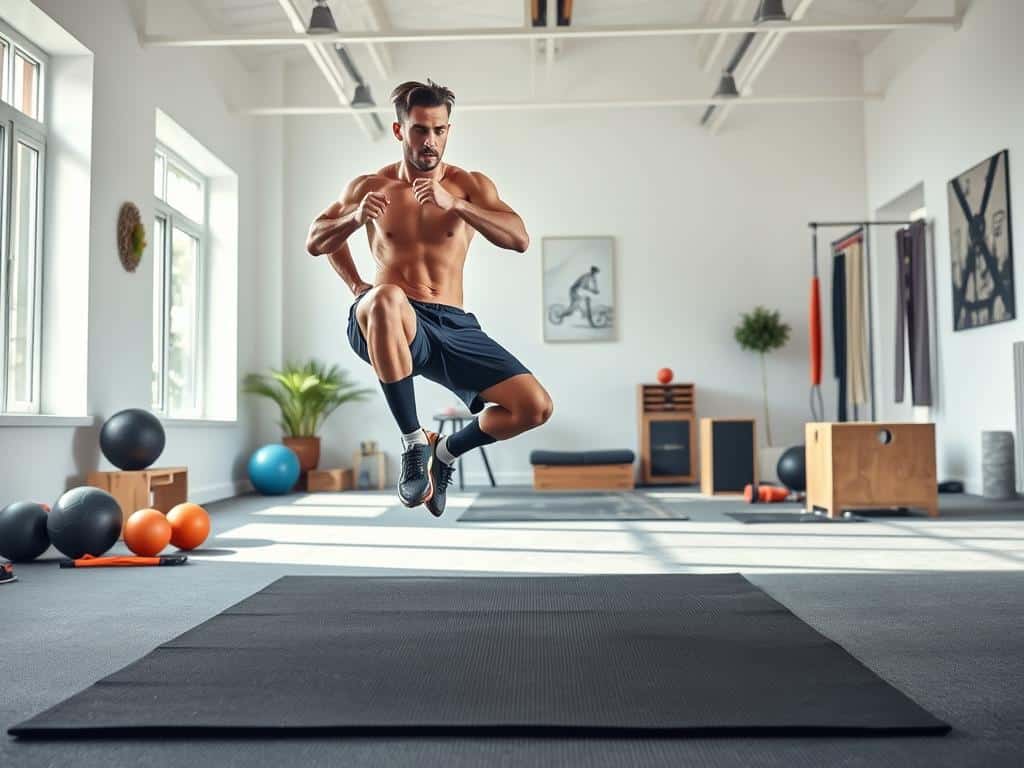
Warm-up
Begin with pogos: 2 sets of 30 seconds to prime ankle stiffness. Follow with quick line hops—forward and lateral—for foot speed and readiness.
Main set
Block: 3 rounds of box jumps (6–10 reps), lateral power shuffle (6 each side or 10–20 yards), then squat jumps (12 reps). Stay intentional on each rep.
Density and rest
Keep rest at 30 seconds between sets to maintain intensity without collapsing form. Land softly: knees track, hips back, chest up. Reset before every rep.
- Scale volume by trimming reps, not rushing form.
- Rotate the lateral drill weekly with skater jumps or step-up jumps.
- If you train twice per week, schedule this on non-consecutive days to aid recovery.
- Want a fuller warm-up? See essential warm-up drills: essential warm-up drills.
| Segment | Drill | Timing/Reps |
|---|---|---|
| Warm-up | Pogos, line hops | 2×30s each |
| Main | Box jumps, lateral shuffle, squat jumps | 3 sets; 6–10 / 6 per side / 12 |
| Rest | Between sets | 30 seconds |
Program design: duration, frequency, and training volume per week
Plan your block like a coach: clear phases, measured loads, and a finish-line taper. Build training in 7-week blocks. This length is proven and easy to manage.
Aim for 1–2 sessions per week. Keep total jumps near ~80 per session. Split them across vertical, horizontal, and lateral work.
Keep inter-rep rest under 15 seconds and at least 30 seconds between sets. Allow 24–48 hours between sessions so you recover and return sharp.
- Progressive overload: add 5–10 jumps weekly, raise box height slightly, or swap to a harder drill.
- Taper: in the final 7–10 days cut volume 30–50% but keep intensity high to peak.
- Surface & recovery: favor grass or turf; if indoors, use lower drops and softer landings.
| Phase | Weeks | Session focus |
|---|---|---|
| Build | 1–4 | Accumulate ~80 jumps; emphasize form and varied patterns |
| Push | 5–6 | Raise intensity; small volume increases; maintain quality |
| Taper & peak | 7 (±1) | Cut volume 30–50%; keep maximal efforts but fewer sets |
Sets, reps, and rest: structuring sessions for effectiveness
Smart session structure turns short, intense jumps into lasting speed and power gains.
Use small sets: 3–5 reps for high-intent jump work and 8–12 for submaximal elastic drills. Keep inter-rep contact short (
Place this work first in a session when you are fresh. Pair springy drills with short accelerations after full recovery to boost linear sprint transfer.
Track weekly training volume, progress slowly, and cue form every rep: tall chest, hips back, knees tracking, soft land. Female soccer players follow the same rules—volume control and intent matter.
Simple template: pick 2–3 jump options, 3–4 sets each, set rest and keep intent maximal. Quality over quantity wins!


